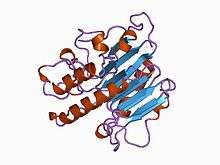Carotenoid oxygenase
Carotenoid oxygenases are a family of enzymes involved in the cleavage of carotenoids to produce, for example, retinol, commonly known as vitamin A. This family includes an enzyme known as RPE65 which is abundantly expressed in the retinal pigment epithelium where it catalyzed the formation of 11-cis-retinol from all-trans-retinyl esters.
| Retinal pigment epithelial membrane protein | |||||||||
|---|---|---|---|---|---|---|---|---|---|
 The Structure of a Retinal-Forming Carotenoid Oxygenase.[1] | |||||||||
| Identifiers | |||||||||
| Symbol | RPE65 | ||||||||
| Pfam | PF03055 | ||||||||
| InterPro | IPR004294 | ||||||||
| SCOPe | 2biw / SUPFAM | ||||||||
| OPM superfamily | 103 | ||||||||
| OPM protein | 2biw | ||||||||
| |||||||||
Carotenoids such as beta-carotene, lycopene, lutein and beta-cryptoxanthine are produced in plants and certain bacteria, algae and fungi, where they function as accessory photosynthetic pigments and as scavengers of oxygen radicals for photoprotection. They are also essential dietary nutrients in animals. Carotenoid oxygenases cleave a variety of carotenoids into a range of biologically important products, including apocarotenoids in plants that function as hormones, pigments, flavours, floral scents and defence compounds, and retinoids in animals that function as vitamins, visual pigments and signalling molecules.[2] Examples of carotenoid oxygenases include:
- Beta-carotene 15,15'-monooxygenase (BCDO1; EC 1.14.99.36) from animals, which cleaves beta-carotene symmetrically at the central double bond to yield two molecules of retinal.[2]
- Beta-carotene-9',10'-dioxygenase (BCDO2) from animals, which cleaves beta-carotene asymmetrically to apo-10'-beta-carotenal and beta-ionone, the latter being converted to retinoic acid. Lycopene is also oxidatively cleaved.[2]
- 9-cis-epoxycarotenoid dioxygenase from plants, which cleaves 9-cis xanthophylls to xanthoxin, a precursor of the hormone abscisic acid.[3]
- Apocarotenoid-15,15'-oxygenase from bacteria and cyanobacteria, which converts beta-apocarotenals rather than beta-carotene into retinal. This protein has a seven-bladed beta-propeller structure with four hisitidines that hold the iron active centre.[4]
- Retinal pigment epithelium 65 kDa protein (RPE65) from vertebrates which is important for the production of 11-cis retinal during visual pigment regeneration.
Human proteins containing this domain
BCDO2; BCMO1; RPE65;
References
- Kloer DP, Ruch S, Al-Babili S, Beyer P, Schulz GE (April 2005). "The structure of a retinal-forming carotenoid oxygenase". Science. 308 (5719): 267–9. doi:10.1126/science.1108965. PMID 15821095.
- Wyss A (2004). "Carotene oxygenases: a new family of double bond cleavage enzymes". J. Nutr. 134 (1): 246S–250S. PMID 14704328.
- Cline K, Liu L, Li QB, Tan BC, Joseph LM, Deng WT, Mccarty DR (2003). "Molecular characterization of the Arabidopsis 9-cis epoxycarotenoid dioxygenase gene family". Plant J. 35 (1): 44–56. doi:10.1046/j.1365-313X.2003.01786.x. PMID 12834401.
- Schulz GE, Kloer DP, Ruch S, Al-Babili S, Beyer P (2005). "The structure of a retinal-forming carotenoid oxygenase". Science. 308 (5719): 267–269. doi:10.1126/science.1108965. PMID 15821095.
Further reading
- Nicoletti A, Wong DJ, Kawase K, Gibson LH, Yang-Feng TL, Richards JE, Thompson DA (April 1995). "Molecular characterization of the human gene encoding an abundant 61 kDa protein specific to the retinal pigment epithelium". Hum. Mol. Genet. 4 (4): 641–9. doi:10.1093/hmg/4.4.641. PMID 7633413.